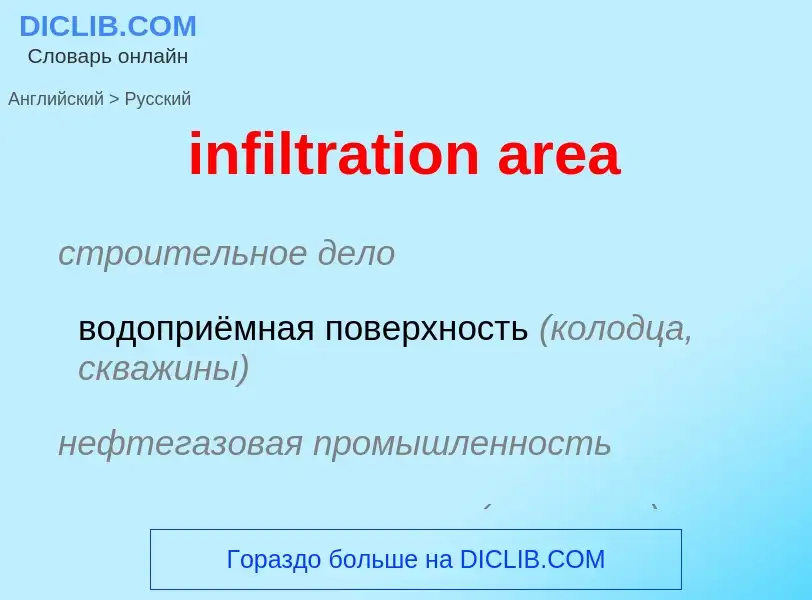Translation and analysis of words by ChatGPT artificial intelligence
On this page you can get a detailed analysis of a word or phrase, produced by the best artificial intelligence technology to date:
- how the word is used
- frequency of use
- it is used more often in oral or written speech
- word translation options
- usage examples (several phrases with translation)
- etymology
infiltration area - translation to russian
строительное дело
водоприёмная поверхность (колодца, скважины)
нефтегазовая промышленность
площадь дренирования (скважины)
нефтегазовая промышленность
просачивание воды (поверхностной и атмосферной)
Wikipedia

In warfare, infiltration tactics involve small independent light infantry forces advancing into enemy rear areas, bypassing enemy frontline strongpoints, possibly isolating them for attack by follow-up troops with heavier weapons. Soldiers take the initiative to identify enemy weak points and choose their own routes, targets, moments and methods of attack; this requires a high degree of skill and training, and can be supplemented by special equipment and weaponry to give them more local combat options.
Forms of these infantry tactics were used by skirmishers and irregulars dating back to classical antiquity, but only as a defensive or secondary tactic; decisive battlefield victories were achieved by shock combat tactics with heavy infantry or heavy cavalry, typically charging en masse against the primary force of the opponent. By the time of early modern warfare, defensive firepower made this tactic increasingly costly. When trench warfare developed to its height in World War I, most such attacks were complete failures. Raiding by small groups of experienced soldiers, using stealth and cover was commonly employed and often successful, but these could not achieve decisive victory.
Infiltration tactics developed slowly through World War I and early World War II, partially as a way of turning these harassing tactics into a decisive offensive doctrine. At first, only special units were trained in these tactics, typified by German Stoßtruppen (storm troops). By the end of World War II, almost all regular ground forces of the major powers were trained and equipped to employ forms of infiltration tactics, though some specialize in this, such as commandos, long-range reconnaissance patrols, US Army Rangers, airborne and other special forces, and forces employing irregular warfare.
While a specialist tactic during World War I, infiltration tactics are now regularly fully integrated as standard part of the modern maneuver warfare, down to basic fire and movement at the squad and section level, so the term has little distinct meaning today. Infiltration tactics may not be standard in modern combat where training is limited, such as for militia or rushed conscript units, or in desperate attacks where an immediate victory is required. Examples are German Volkssturm formations at the end of World War II, and Japanese banzai attacks of the same period.


![Mametz]] Valley, August 1916, during the [[Battle of the Somme]] Mametz]] Valley, August 1916, during the [[Battle of the Somme]]](https://commons.wikimedia.org/wiki/Special:FilePath/British 39th Siege Battery RGA Somme 1916.jpg?width=200)
![The [[Brusilov Offensive]], with starting positions on 4 June 1916 (thick solid line), initial advances on 16 June (thinner jagged line), and final positions on 20 September (dotted line)<!-- . Arrows show the direction of attacks of the 3rd, 8th, 11th, 7th and 9th armies (the last unlabeled). The original objective, Lemburg, would be near the left edge of the map in the center.--> The [[Brusilov Offensive]], with starting positions on 4 June 1916 (thick solid line), initial advances on 16 June (thinner jagged line), and final positions on 20 September (dotted line)<!-- . Arrows show the direction of attacks of the 3rd, 8th, 11th, 7th and 9th armies (the last unlabeled). The original objective, Lemburg, would be near the left edge of the map in the center.-->](https://commons.wikimedia.org/wiki/Special:FilePath/Brusilov offensive.jpg?width=200)
![''Stoßtruppen'']] (stormtroopers) rising from trenches to attack, equipped with satchel-bags of grenades ''Stoßtruppen'']] (stormtroopers) rising from trenches to attack, equipped with satchel-bags of grenades](https://commons.wikimedia.org/wiki/Special:FilePath/Bundesarchiv Bild 146-1974-132-26A, Stoßtrupp.jpg?width=200)
![Mix of new and old French tactics help capture [[Neuville-Saint-Vaast]], but with heavy casualties, 9 May – 9 June 1915, as part of the [[Second Battle of Artois]] Mix of new and old French tactics help capture [[Neuville-Saint-Vaast]], but with heavy casualties, 9 May – 9 June 1915, as part of the [[Second Battle of Artois]]](https://commons.wikimedia.org/wiki/Special:FilePath/Capture of Neuville St, Vaast, 9 May - 9 June 1915.jpg?width=200)
![Galicia]], dug through the snow-covered soil Galicia]], dug through the snow-covered soil](https://commons.wikimedia.org/wiki/Special:FilePath/Fighting on the Russian Front, Where the Hardship of War are Aggravated by the Bitter Cold of Winter (LOC) (6331261973).jpg?width=200)
![Colonel [[Georg Bruchmüller]], nicknamed ''Durchbruchmüller'' as a combination of the German word ''Durchbruch'' (breakthrough) with his name, for his fame with using ''hurricane'' artillery bombardments for breakthroughs in World War I Colonel [[Georg Bruchmüller]], nicknamed ''Durchbruchmüller'' as a combination of the German word ''Durchbruch'' (breakthrough) with his name, for his fame with using ''hurricane'' artillery bombardments for breakthroughs in World War I](https://commons.wikimedia.org/wiki/Special:FilePath/Oberst Bruchmueller.jpg?width=200)
![Initial success of [[Operation Michael]] within the [[German spring offensive]], 21 March – 5 April 1918 Initial success of [[Operation Michael]] within the [[German spring offensive]], 21 March – 5 April 1918](https://commons.wikimedia.org/wiki/Special:FilePath/Operation Michael 1918.jpg?width=200)
![Map detailing exact positions and timing of the planned [[creeping barrage]] for the Canadian assault on [[Vimy Ridge]], April 1917 Map detailing exact positions and timing of the planned [[creeping barrage]] for the Canadian assault on [[Vimy Ridge]], April 1917](https://commons.wikimedia.org/wiki/Special:FilePath/Vimy Ridge 1917-barrage map.jpg?width=200)

![Relationship between [[impervious surfaces]] and infiltration Relationship between [[impervious surfaces]] and infiltration](https://commons.wikimedia.org/wiki/Special:FilePath/Natural & impervious cover diagrams EPA.jpg?width=200)
